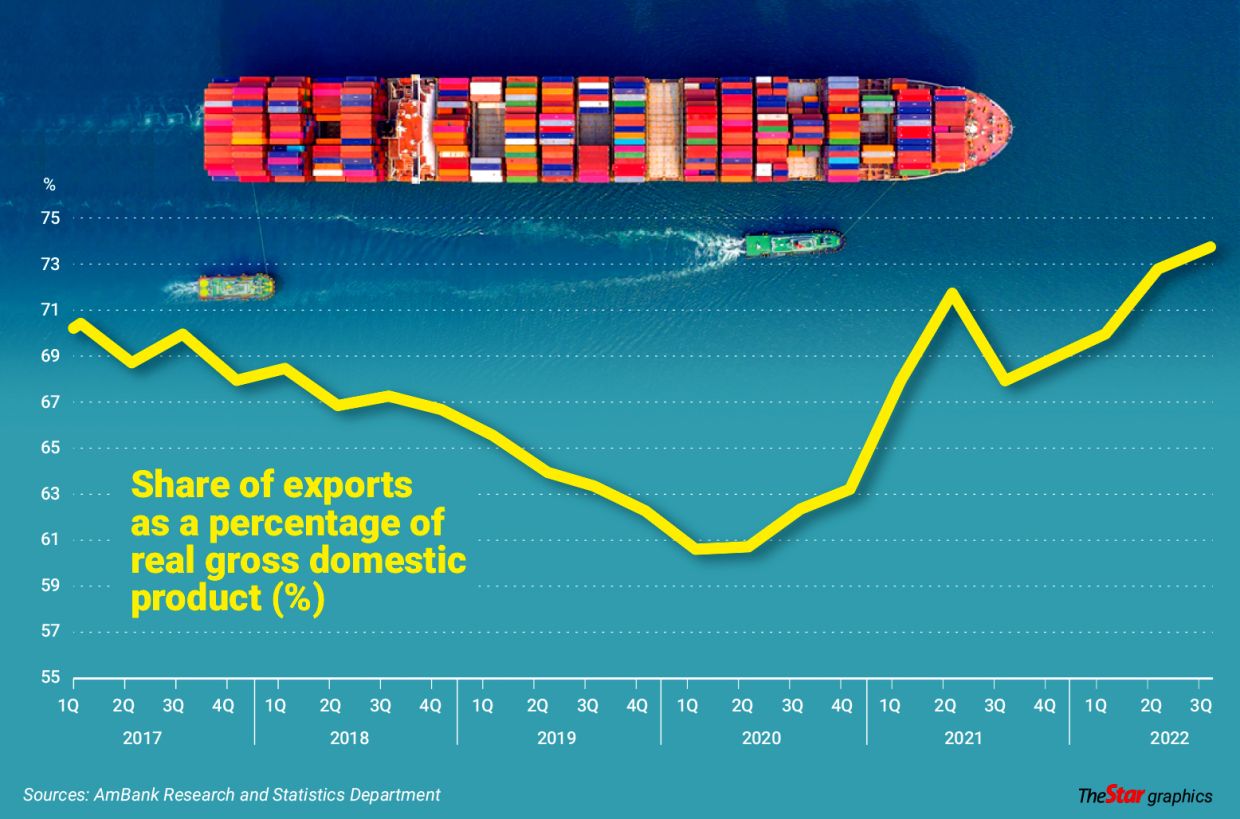Juwai IQI global chief economist Shan Saeed
PETALING JAYA: The Malaysian economy has the necessary buffers to withstand downside risks amid a challenging business environment exacerbated by the looming global recession next year, say economists.
Among the factors that may cushion the domestic economy from the global recessionary risks are a well-capitalised financial system, local currency denominated debts and China’s gradual exit from its zero-Covid strategy.
The World Bank has estimated that a one percentage point decline in the growth of the Group of Seven countries, excluding Japan, could result in Malaysia’s gross domestic product (GDP) growth falling by a similar quantum while a one percentage point fall in China’s growth would see a corresponding 0.7 percentage point drop in the country’s GDP growth.
This is expected to reduce income and job creation, leading to lower consumer spending as well as reduced business expansion and investment.
Sunway University economics professor Yeah Kim Leng told StarBiz the rapidly cooling global economy might worsen into a global recession next year and it is expected to transmit a negative demand shock to the local economy via the trade and direct investment channel.
He said the rising importance of exports to the country’s growth is evidenced by the rise of its share to GDP from 69% in 2021 to 72% in the first three quarters of 2022.
Yeah said, however, the momentum generated by the strong recovery in private consumption this year could help the local economy to withstand a mild softening in external demand in 2023 but would not be able to offset a more severe or synchronised global downturn.
Economists concurred that the widely expected continuation of monetary and financial tightening in the US and European economies to contain high inflation would dampen economic growth.
They said it would also cause continued volatility and uncertainty in global financial markets and capital outflows from emerging markets, including Malaysia.
Meanwhile, Bloomberg Economics expects the US Federal Reserve’s (Fed) benchmark interest rate to hit 5% in early 2023, and possibility of more pain to come.
With higher borrowing costs hammering rate-sensitive industries from real-estate to autos, it is predicting a US recession in the second half of 2023.
On a positive note, Yeah, said Malaysia’s financial system is well-capitalised, sufficiently deep and liquid to withstand foreign capital withdrawals as well as debt market turbulence arising from soaring interest rates, currency depreciation and risk-off sentiment.
“Moreover, the country’s corporate and government debt is denominated in the local currency and this will avert the dreaded ballooning of foreign debt repayments due to sharp currency depreciation. Nevertheless, the ensuing tighter financial conditions and increased market uncertainty could dampen growth through the financial channel,” he said.
Due to the multiple global risks, the GDP growth for 2023 is revised slightly downwards to between 3.5% and 4%, he said.
The local economy is expected to grow by 4% to 5% in 2023.
Bank Negara expects the full-year 2022 growth to exceed the 7% projected earlier due to the healthy growth in the first nine months of this year.
The economy posted a robust GDP growth of 14.2% in the third quarter (3Q22).
Juwai IQI global chief economist Shan Saeed said the most important variable that would drag the global economy in 2023 would be the deep recession in the United States and stagflation in many economies.
The United States is the third largest trading partner of Malaysia with a share of 11% in trade based on the January to October 2022 data.
“If the largest economy goes into a deep recession, Malaysia needs to find new markets, especially the Cooperation Council for the Arab States of the Gulf, or Africa to minimise the impact of the recession.
“In my opinion, things will be very challenging next year but can be manageable if policy frameworks remain consistent and structured to maintain economic confidence among local investors,” he said.
Shan maintained his GDP forecast growth for 2022 at between 6.5% and 7% for 2022, and 4% to 5% for 2023.
He said this would be premised on, among others, Malaysia’s macroeconomic stability, domestic consumption, and its trade numbers that are expected to remain strong.
For the government to maintain economic confidence with the global economic fragilities expected to worsen in 2023, it must ensure that there are macroeconomic stability, consistency of policies, strong trade and investment in infrastructure.
As a small and open economy, Malaysia is not spared from the changes in external economic development, according to Bank Islam (M) Bhd chief economist Firdaos Rosli.
For example, he said the United States and the European Union are Malaysia’s largest non-traditional trading partners.
Malaysia’s net exports account for about 6% of its GDP, with north America and Europe accounting for about 20% of the country’s total trade.
Bloomberg Economics’ base case is that high energy costs and rate hikes by the European Central Bank would tip the bloc into recession with GDP shrinking 0.1% in 2023.
“We estimate that the correlation between the United States and Malaysian economies is 81.9%, whereas it is much higher with the eurozone at 88.9%. Therefore, a slowdown or even a recession in the two economies will impact the country’s growth in 2023.
“The silver lining for Malaysia, and to a certain extent South-East Asia, is China’s gradual exit from its zero-Covid strategy. In the event of an economic reopening, we expect a pick-up in tourism receipts and inward foreign direct investments from China. This will give Malaysia the necessary buffer against the downside risks from the West,” Firdaos said.
On GDP growth, he said the bank’s latest forecast for 4Q22 comes in at 4.8%, with 2022 growth at 8.1%. For 2023, it is penciling in 4.5%, subject to further changes, he added.
RAM Ratings senior economist and head of economic research Woon Khai Jhek projected a slower GDP growth in 2023 of between 4% and 5% compared with 8.2% for this year.
He said Malaysia could not avoid the ripple effects from the slower global economic growth, particularly the slowdown in consumer electronic demands which would impact the semiconductor sector.
The country’s GDP for the three quarters of this year grew 9.3% year-on-year underpinned by the reopening of the economy which saw a robust recovery in private sector activities.
Economist Intelligence Corporate Network’s director for South-East Asia Sumana Rajarethnam was quoted as saying that the Russia-Ukraine war would last five more years and would hit global GDP growth and continue to keep commodity prices elevated.
The GDP growth on a global scale would likely decline to 1.5% next year, he said, adding that despite challenging times, there are still bright spots and opportunities that the South-East Asian countries could benefit from.






